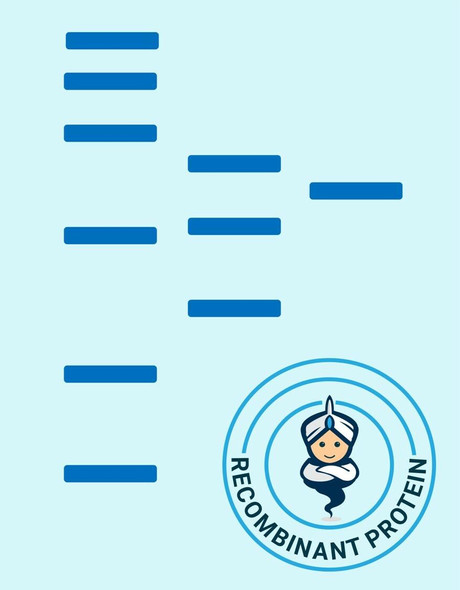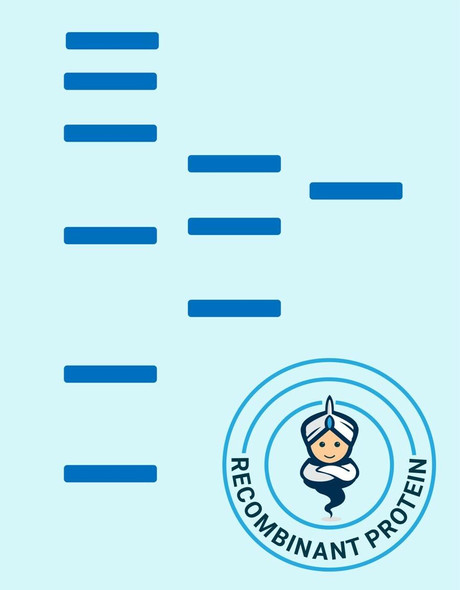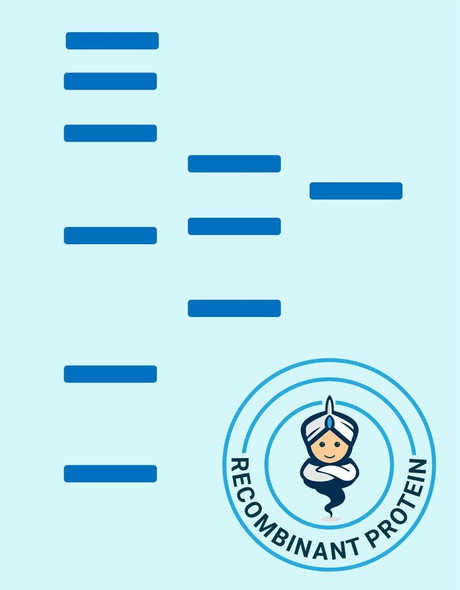Human CCL16 Recombinant Protein (RPPB1108)
- SKU:
- RPPB1108
- Product type:
- Recombinant Protein
- Size:
- 20ug
- Species:
- Human
- Target:
- CCL16
- Synonyms:
- C-C motif chemokine 16
- Small-inducible cytokine A16
- IL-10-inducible chemokine
- Chemokine LEC
- Source:
- Escherichia Coli
- Uniprot:
- O15467
Description
| Product Name: | Human CCL16 Recombinant Protein |
| Product Code: | RPPB1108 |
| Size: | 20µg |
| Species: | Human |
| Target: | CCL16 |
| Synonyms: | C-C motif chemokine 16, Small-inducible cytokine A16, IL-10-inducible chemokine, Chemokine LEC, Monotactin-1, Chemokine CC-4, Lymphocyte and monocyte chemoattractant, CCL-16, HCC-4, HCC4, NCC4, NCC-4, Liver Expressed Chemokine, LMC, LCC-1, LCC1, MTN-1, MTN1, SCYL4, ckB12, SCYA16, LEC, ILINCK, MGC117051. |
| Source: | Escherichia Coli |
| Physical Appearance: | Sterile Filtered White lyophilized (freeze-dried) powder. |
| Formulation: | The CCL16 protein was lyophilized from a concentrated (1mg/ml) sterile solution containing 20mM PBS pH-7.4 and 0.15M sodium chloride. |
| Solubility: | It is recommended to reconstitute the lyophilized CCL16in sterile 18M?-cm H2O not less than 100µg/ml, which can then be further diluted to other aqueous solutions. |
| Stability: | Lyophilized CCL16 although stable at room temperature for 3 weeks, should be stored desiccated below -18°C. Upon reconstitution CCL16 should be stored at 4°C between 2-7 days and for future use below -18°C.For long term storage it is recommended to add a carrier protein (0.1% HSA or BSA).Please prevent freeze-thaw cycles. |
| Purity: | Greater than 97.0% as determined by:(a) Analysis by RP-HPLC.(b) Analysis by SDS-PAGE. |
| Amino Acid Sequence: | QPKVPEWVNTPSTCCLKYYEKVLPRRLVVGYRKALNCHLPAIIFVTKRNREVCTNP NDDWVQEYIKDPNLPLLPTRNLSTVKIITAKNGQPQLLNSQ |
| Biological Activity: | Determined by its ability to chemoattract total human monocytes using a concentration range of 10-100 ng/ml corresponding to a Specific Activity of 10,000-100,000IU/mg. |
Human CCL16, also called HCC-4, liver-expressed chemokine (LEC), and lymphocyte and monocyte chemoattractant (LMC), is a novel CC chemokine recognized by bioinformatics. NCC-4 cDNA encodes a 120 amino acids along with a 23 amino acids signal peptide that is cleaved to generate 97 amino acid protein. HCC4 is vaguely related to other CC chemokines, showing less than 30% sequence identity. Among CC chemokines, CCL-16 has the largest similarity to HCC-1. 2 potential polyadenylation signals are present on the human HCC-4 gene, and as a result, 2 transcripts containing roughly 1,500 base pairs and 500 base pairs have been detected. HCC-4 is expressed weakly by some lymphocytes, including NK cells, T cells, and some T cell clones. The expression of HCC-4 in monocytes is greatly upregulated in the presence of IL-10. CCL16 shows chemotactic activity for lymphocytes and monocytes rather than to neutrophils. NCC-4 has potent myelosuppressive activity, suppresses proliferation of myeloid progenitor cells. CCL16 demonstrates chemotactic activity for monocytes and thp-1 monocytes, rather than for resting lymphocytes and neutrophils. HCC-4 induces a calcium flux in thp-1 cells that desensitized prior to the expression of rantes.
CCL16 Human Recombinant produced in E.Coli is a non-glycosylated, Polypeptide chain containing 97 amino acids and having a molecular mass of 11.2 kDa. The CCL16 is purified by proprietary chromatographic techniques.
| UniProt Protein Function: | CCL16: Shows chemotactic activity for lymphocytes and monocytes but not neutrophils. Also shows potent myelosuppressive activity, suppresses proliferation of myeloid progenitor cells. Recombinant SCYA16 shows chemotactic activity for monocytes and THP-1 monocytes, but not for resting lymphocytes and neutrophils. Induces a calcium flux in THP-1 cells that were desensitized by prior expression to RANTES. Belongs to the intercrine beta (chemokine CC) family. |
| UniProt Protein Details: | Protein type:Chemokine; Secreted; Secreted, signal peptide; Motility/polarity/chemotaxis Chromosomal Location of Human Ortholog: 17q12 Cellular Component: extracellular space; extracellular region Molecular Function:chemokine activity; chemoattractant activity Biological Process: cell-cell signaling; positive chemotaxis; cell communication; immune response; inflammatory response; chemotaxis |
| NCBI Summary: | This gene is one of several cytokine genes clustered on the q-arm of chromosome 17. Cytokines are a family of secreted proteins involved in immunoregulatory and inflammatory processes. The CC cytokines are proteins characterized by two adjacent cysteines. The cytokine encoded by this gene displays chemotactic activity for lymphocytes and monocytes but not for neutrophils. This cytokine also shows a potent myelosuppressive activity and suppresses proliferation of myeloid progenitor cells. The expression of this gene is upregulated by IL-10. [provided by RefSeq, Jul 2008] |
| UniProt Code: | O15467 |
| NCBI GenInfo Identifier: | 6094382 |
| NCBI Gene ID: | 6360 |
| NCBI Accession: | O15467.1 |
| UniProt Secondary Accession: | O15467,Q4KKU0, |
| UniProt Related Accession: | O15467 |
| Molecular Weight: | 13,600 Da |
| NCBI Full Name: | C-C motif chemokine 16 |
| NCBI Synonym Full Names: | chemokine (C-C motif) ligand 16 |
| NCBI Official Symbol: | CCL16 |
| NCBI Official Synonym Symbols: | LEC; LMC; NCC4; CKb12; HCC-4; LCC-1; Mtn-1; NCC-4; SCYL4; ILINCK; SCYA16 |
| NCBI Protein Information: | C-C motif chemokine 16; monotactin-1; chemokine LEC; chemokine CC-4; new CC chemokine 4; liver CC chemokine-1; IL-10-inducible chemokine; liver-expressed chemokine; small-inducible cytokine A16; lymphocyte and monocyte chemoattractant; small inducible cytokine subfamily A (Cys-Cys), member 16 |
| UniProt Protein Name: | C-C motif chemokine 16 |
| UniProt Synonym Protein Names: | Chemokine CC-4; HCC-4; Chemokine LEC; IL-10-inducible chemokine; LCC-1; Liver-expressed chemokine; Lymphocyte and monocyte chemoattractant; LMC; Monotactin-1; MTN-1; NCC-4; Small-inducible cytokine A16 |
| Protein Family: | Lectin-like protein |
| UniProt Gene Name: | CCL16 |
| UniProt Entry Name: | CCL16_HUMAN |










